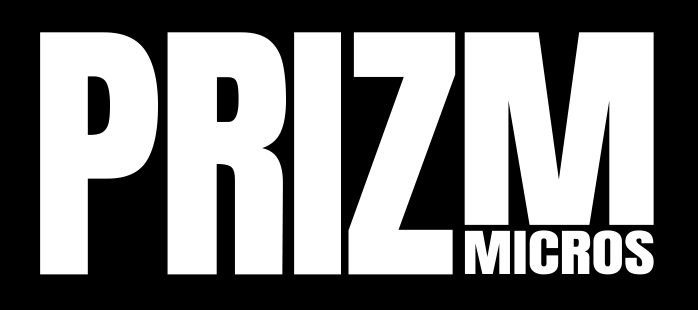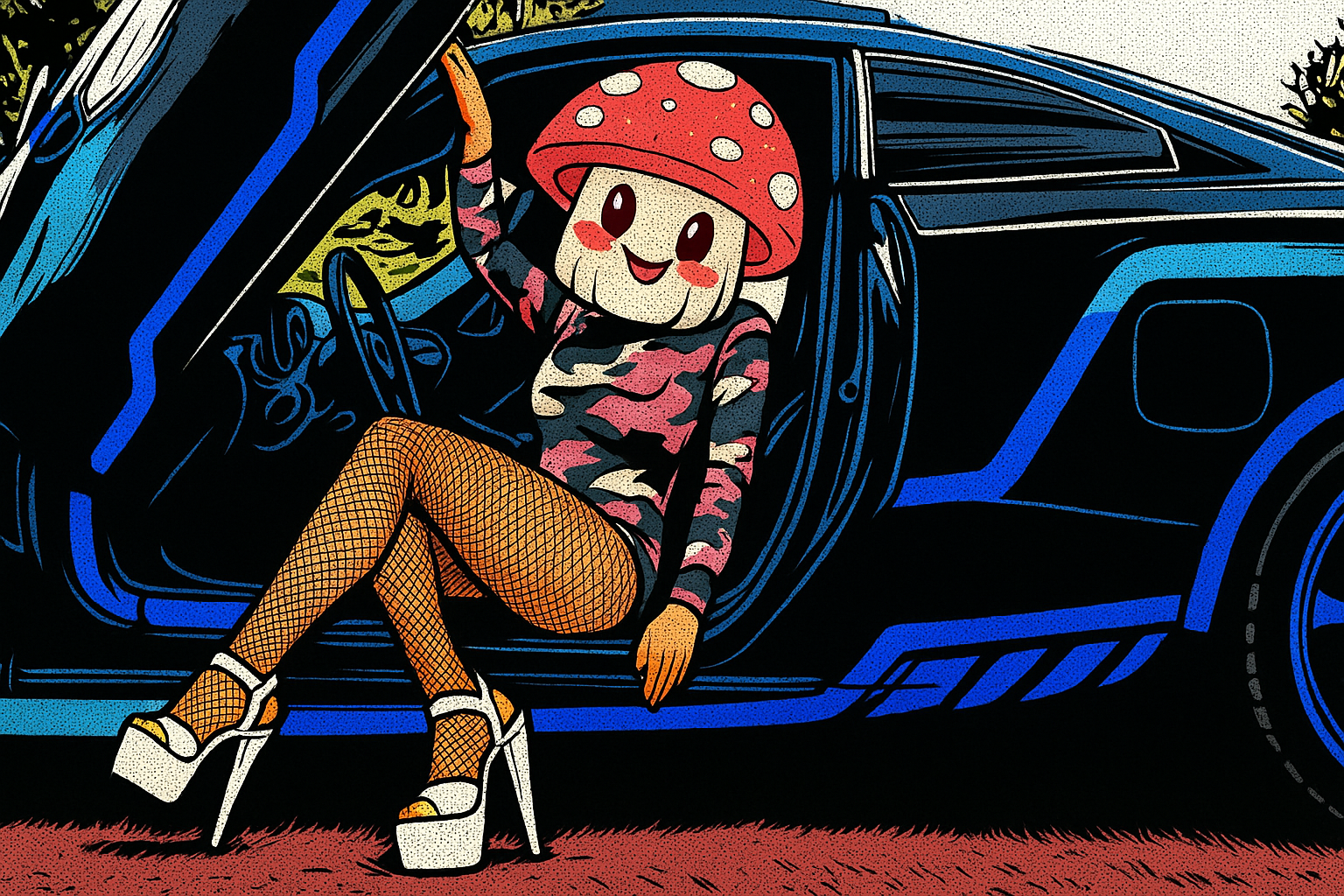Gas station mushroom gummies are often weak, mislabeled, or misleading products that rarely contain actual psychedelic compounds like psilocybin or muscimol. Most are made with functional mushrooms or synthetic fillers, offering little to no effect. Consumers should check for transparent labeling, lab testing, and legal ingredient disclosures before use.
Gas Station Mushroom Gummies at a Glance
- Most gas station mushroom gummies are not psychedelic, despite the name.
- Many are mislabeled, under-dosed, or contain unlisted compounds.
- Psilocybin and muscimol are not legal for general retail sale, so legit versions won’t be sold at convenience stores.
- Key red flags: no dosage listed, no third-party lab test, vague ingredient names.
- For a safe, reliable experience, look for transparency, lab testing, and legal clarity,not a sketchy label and a $7.99 price tag.
Gas Station Mushroom Gummies: Real Deal or Risky Gimmick?
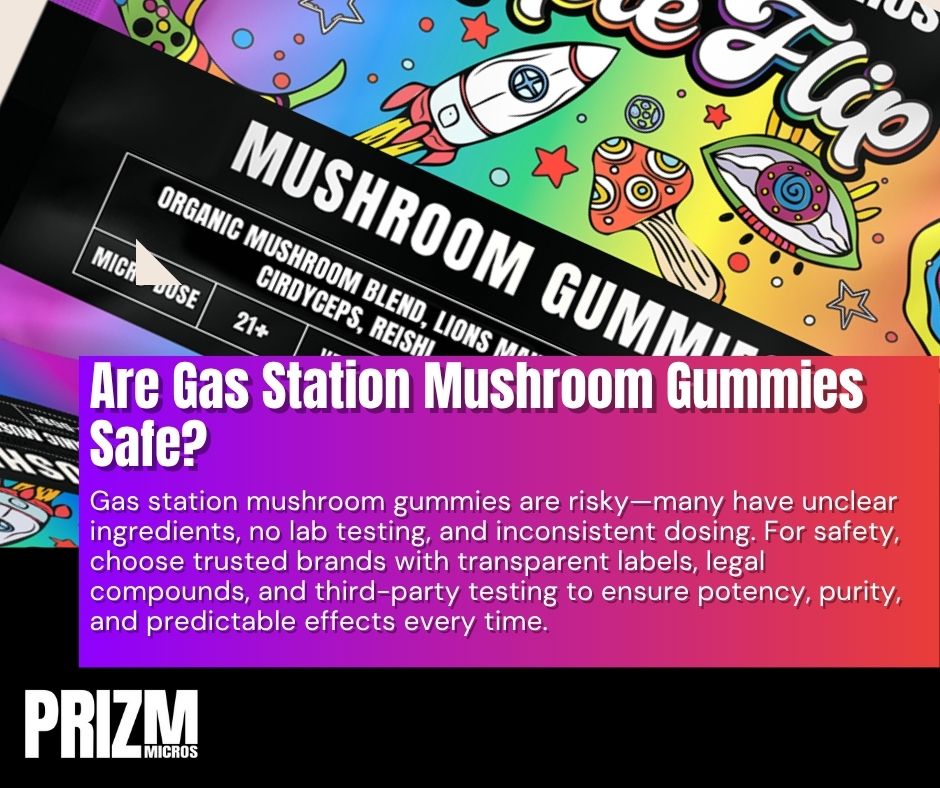
Let’s talk gas station mushroom gummies. You’ve probably seen them on a counter next to vape pens and energy shots with a name that sounds like it was made in a lab that also sells novelty lighters. “Shroomz,” “Fungtastic,” or “Spacey Bears” in neon fonts promising “psychedelic bliss” for $4.99. It’s wild out there.
I started PRIZM Micros after seeing too many so-called “psychedelic” products that were weak, mislabeled, or downright sketchy. People deserve mood-boosting, legal options they can trust, so let’s unpack what gas station mushroom gummies really are, what’s inside, and how to spot the safe ones.
What Are Gas Station Mushroom Gummies, Really?
Most gas station mushroom gummies fall into one of three categories:
- Functional Mushroom Fakes: Gummies with zero psychedelic content, often labeled with buzzwords like “nootropic,” “adaptogen,” or “mood booster.” They use lion’s mane, reishi, or cordyceps, but package it to look trippy.
- Mislabeled or Gray-Market Psychedelics: Some products claim to contain amanita muscaria extract (legal in most states) or use vague terms like “psychoactive blend.” But there’s no transparency on dosage, sourcing, or lab testing.
- Total Duds or Potential Hazards: A few are nothing more than gelatin, flavoring, and questionable “proprietary blends” that might include synthetic compounds, or nothing at all.
The big problem? Most people don’t know which one they’re buying until they chew and cross their fingers. That’s not how this should work.
How to Read the Label (And Spot the Red Flags)
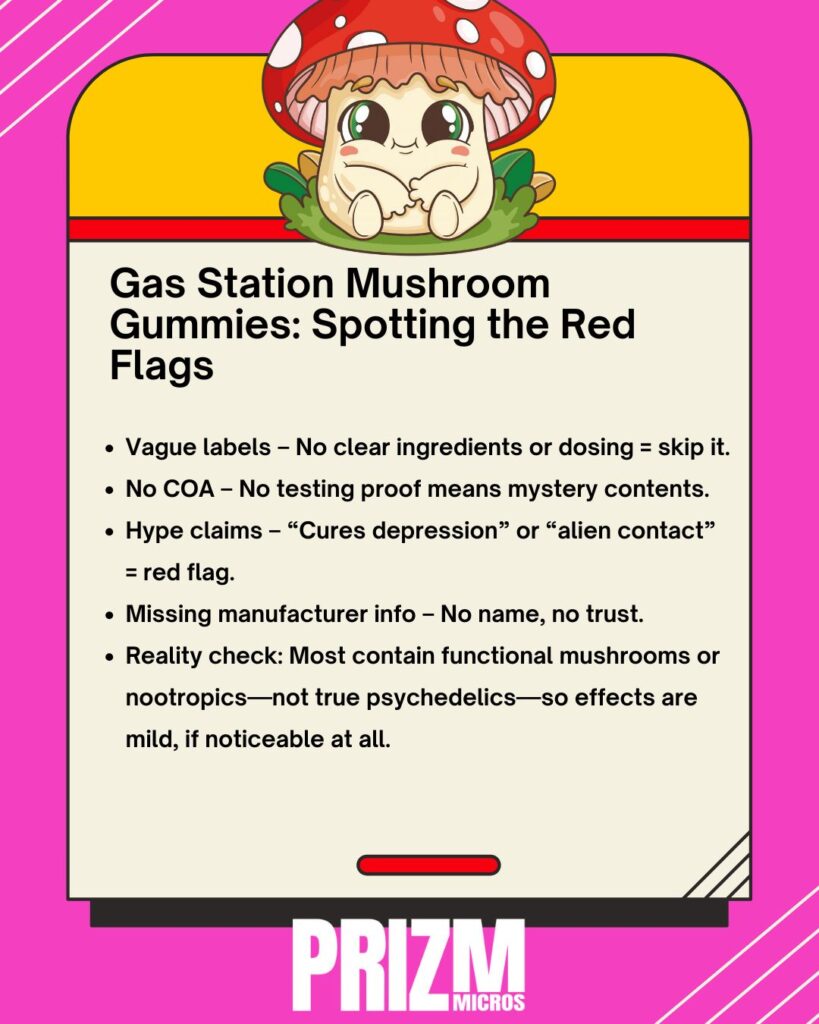
Most gas station gummies rely on what I call “vibe marketing.” They use trippy fonts, cartoon mushrooms, and “chill” language without actually telling you what’s inside. If you’ve ever squinted at a label trying to decode whether you’re about to microdose or just ingest mushroom-shaped fruit snacks, this one’s for you.
Here’s what to look for (and what to run from):
- Missing or vague ingredient lists: If it just says “proprietary blend” or doesn’t list a compound like muscimol, psilocybin, or a clearly identified legal analog, skip it.
- No dosing information: A legit product will tell you how many milligrams per gummy and what compound you’re consuming. “One strong dose” is not a dosage.
- No third-party testing: If there’s no QR code or link to a Certificate of Analysis (COA), you’re trusting a mystery manufacturer with your brain.
- Weird health claims: Anything that promises to “cure depression” or “connect you to aliens” is probably hiding something (or overcompensating for nothing).
- Manufacturer info: If there’s no company name, website, or address, treat it like a red flag with a smiley face on it.
Real talk: if a company can’t be transparent about what’s in their product, why would you trust them to mess with your neurotransmitters?
What to Expect (vs. What They Promise)
Here’s where the gas station magic trick usually falls apart. These gummies look psychedelic, sound psychedelic… but often feel like a Flintstones vitamin, if you’re lucky.
What they promise:
- “Intense clarity”
- “Vibes like a psilocybin trip”
- “Next-level mood elevation”
- “Visuals without the comedown”
What actually happens:
- Mild relaxation, if anything
- Slight drowsiness (likely from added melatonin or L-theanine)
- Sugar crash
- Or… nothing at all
Most of these gummies are not dosed with psilocybin or muscimol. If they’re legal nationwide and sitting next to gas station boner pills, they’re almost always functional mushroom blends (like lion’s mane or reishi), maybe spiked with CBD or nootropics, but not true psychedelics.
Not saying that’s bad. But it’s a big difference between microdosing and just munching a mushroom-flavored chill chew. That gap is where a lot of consumer frustration, and frankly, trust erosion, happens.
The Real Risks: What Happens If You Trust the Wrong Gummy
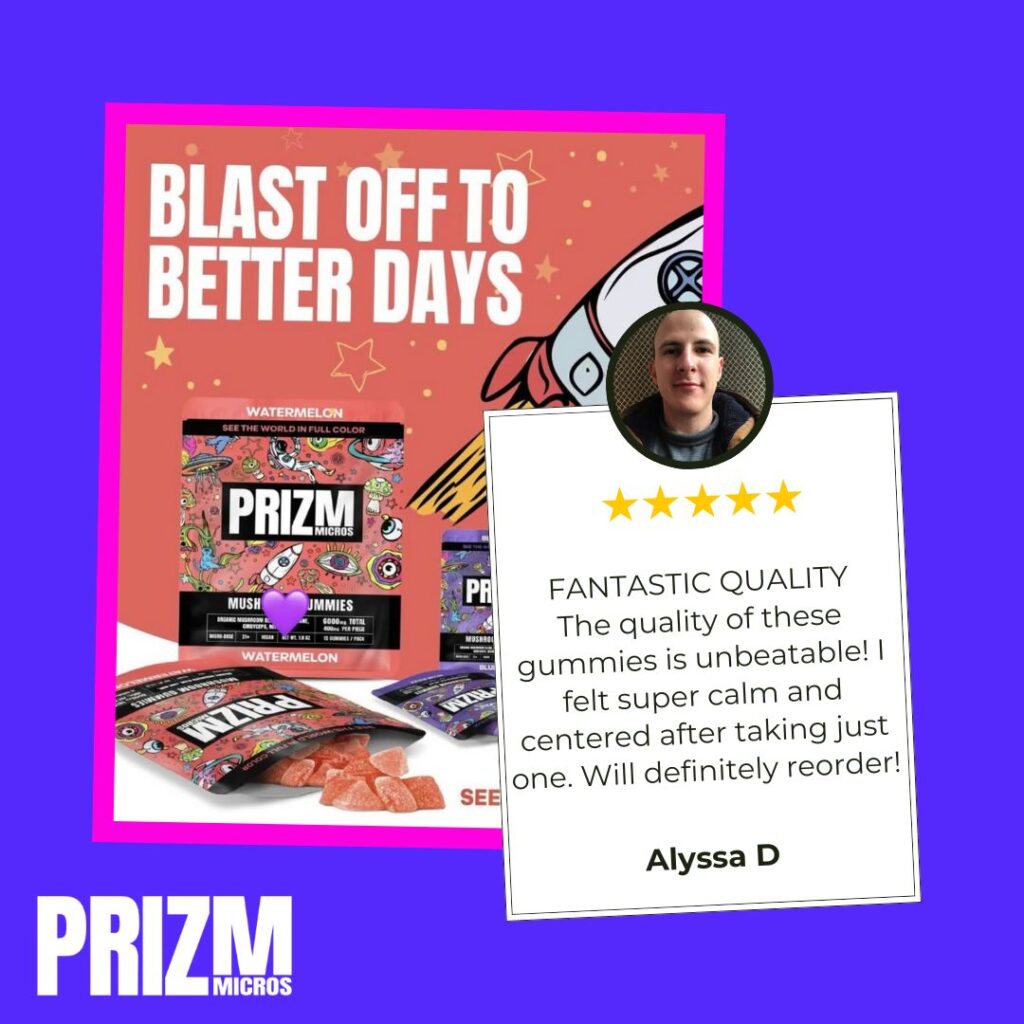
Let’s break the illusion: just because something is sold in a store doesn’t mean it’s safe, or even legal.
Here’s what’s at stake if you grab the wrong gummy:
- Unknown Ingredients: Some of these are mystery blends. No COA, no third-party testing, just “proprietary formula” and vibes. That’s not enough.
- Mislabeling: A gummy might say it contains amanita or “psychedelic mushroom blend,” but deliver a barely-there dose, or none at all. Worse? Some contain unlisted substances that can mess with your body or interact with meds.
- Contamination: Mold, heavy metals, or poorly preserved compounds can cause nausea, dizziness, or worse. If you’ve ever thrown up from a gas station edible, you’re not alone.
- Legality Confusion: Products labeled as “shrooms” often toe a gray area. Some include banned analogs or skirt regulations via labeling loopholes. You could end up with something technically illegal depending on your state.
- False Expectations: People take these hoping for a shift in mood, mindset, or perception. Instead, they get sugar-coated disappointment, or worse, they think all mushroom gummies are bunk because of one sketchy bite.
Point is: it’s not worth risking your mental clarity, your money, or your body for a mislabeled maybe.
How to Spot a Fake or Unsafe Mushroom Gummy
You don’t need a chemistry degree to spot a sketchy product. Here’s your cheat sheet for decoding the red flags:
1. No Clear Ingredients List
If the label says “proprietary blend” but doesn’t spell out what’s inside, that’s a no-go. Real brands proudly list active ingredients, dosing (in milligrams), and sourcing info.
2. No QR Code or Certificate of Analysis (COA)
Every legit product should have a batch-specific COA from a third-party lab. It proves what’s in it, and what’s not. If the label lacks a scannable QR code linking to lab results, toss it back.
3. Weird Buzzwords or Fake Science
Terms like “magic extract,” “mystical blend,” or “neural expansion complex” are just filler. If the science sounds made up, it probably is.
4. No Brand Info or Contact Details
If there’s no website, no support contact, and no social presence? Huge red flag. Real brands have nothing to hide.
5. Too Cheap to Be True
A potent, responsibly sourced mushroom gummy takes work to produce. If you’re paying $5 for a pack at a gas station, chances are you’re just buying sugar and sketchy marketing.
Functional Mushrooms vs Psychedelic Mushrooms: What’s Actually in These Gummies?
Most gas station mushroom gummies don’t contain psilocybin or muscimol (the compounds that actually create psychedelic effects). What they do contain, if you’re lucky, is a blend of functional mushrooms like lion’s mane, reishi, or cordyceps. These can support focus or relaxation, but they’re not going to send you into an altered state.
Functional Mushrooms (What You’re Likely Getting):
- Lion’s Mane: cognitive support, often used in nootropic stacks
- Reishi: known for calming, adaptogenic properties
- Cordyceps: sometimes included for stamina or energy
Psychedelic Mushrooms (What’s Rarely in Gas Station Gummies):
- Psilocybin: federally illegal; not found in over-the-counter products
- Amanita muscaria (muscimol): technically legal in many states, but often mislabeled or omitted
Here’s the trick: just because a label says “mushroom” doesn’t mean it’s psychedelic. Functional mushrooms are totally legal and legit, but they don’t deliver a trip. If a gas station gummy promises visuals or altered states but lists only lion’s mane or “proprietary blend,” it’s marketing smoke and mirrors.
Real vs Fake Mushroom Gummies: A Side-by-Side Breakdown
Not all mushroom gummies are built the same, and when it comes to gas station shelves, the line between legit and gimmick is razor-thin. Let’s break it down so you know what to look for:
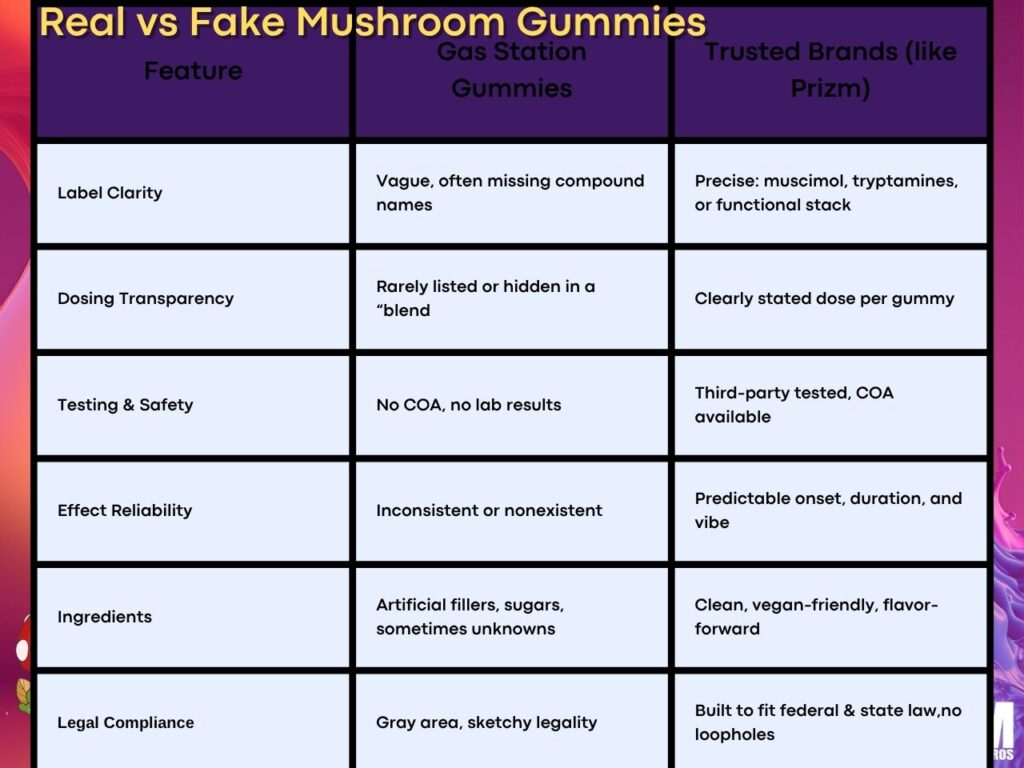
You don’t have to play gummy roulette. If you’re buying blind at a gas station, odds are you’re getting fluff, or worse, a risk.
How to Protect Yourself When Buying Mushroom Gummies
If you’re curious, cautious, or caught in a last-minute road trip impulse, pause before tossing that “shroom gummy” in your cart. Here’s a quick safety checklist I live by (and I wish more people did):
Check the Label, And Not Just for “Mushroom”
If it just says “proprietary mushroom blend” without specifying which mushrooms (like Amanita muscaria or lion’s mane), that’s a red flag. Bonus points if the label includes dosage per gummy and compound type.
Look for COA or Lab Testing
No Certificate of Analysis? That’s a no from me. Legit brands show third-party lab tests on their site or with a QR code on the packaging. If it’s not tested, it’s not trusted.
Know the Legal Landscape
Gas station brands often walk a legal tightrope, especially if they’re implying psilocybin content without saying it outright. Be wary of brands that don’t say what’s actually inside.
Google the Brand
If it doesn’t have a website, real reviews, or any kind of brand story, be skeptical. Mushroom wellness isn’t something you want mystery meat-style.
Ask Yourself: “Would I Eat This If It Wasn’t Psychedelic?”
If it’s loaded with artificial colors, corn syrup, or unknown fillers, would you still put it in your body? The answer should still be “hell no.”

Why We Built Prizm Differently
This is exactly why we created Prizm: to flip the script on shady labeling and gas station gimmicks. We were tired of watching people either get nothing at all… or get something sketchy and unpredictable. So we built our own path:
- Legal, not lazy. Our formulas are built around legal compounds that actually work, and we tell you exactly what’s inside.
- Snackable psychedelics. Our gummies aren’t just trippy branding, they’re precision-dosed, third-party tested, and designed for consistent, feel-good vibes.
- One for focus, two for flow, three if you’re feeling bold. Because real clarity shouldn’t feel like a gamble.
We’re not just a wellness brand. We’re a rebellion against the black-box gummies sitting on that truck stop counter. Built for vibes, backed by science, Prizm is here to elevate how people feel, function, and live. No filler. No fakes. No BS.
Disclaimer
This content is for informational purposes only and does not constitute medical advice or product endorsement. Always consult a healthcare provider before trying any supplement or psychoactive product. The legality and safety of mushroom gummies may vary by region, and consumers are responsible for checking local laws and sourcing from reputable vendors.
Citations
- National Institute on Drug Abuse (NIDA): Information on psychedelic substances and risks.
https://nida.nih.gov - FDA Consumer Updates: Supplements and mislabeling risks in over-the-counter products.
https://www.fda.gov/consumers/consumer-updates - Journal of Psychedelic Studies: Comparative studies on muscimol, psilocybin, and legal mushroom analogs.
https://akjournals.com/view/journals/2054/2054-overview.xml
Third-party lab testing firms (e.g., ACS Laboratory, InfiniteCAL) for insights into mislabeled edibles and contaminants.
